Building and renovation
Warm house, warm heart
Green Ideas editor Greg Roughan
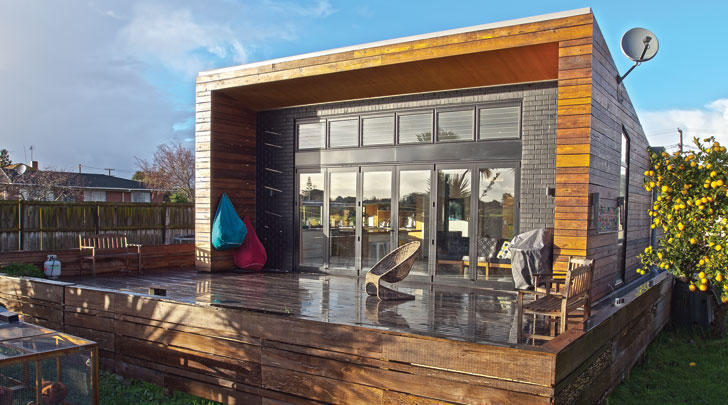
[This story first appeared in the Oct-Nov 2014 issue of Green Ideas magazine.]
Owners: Peta & Joe Davy
Designers: Yellow Fox
Architects: Creative Arch
Builders: Waller Projects
Location: Mangere Bridge, Auckland
Land area: 740m2
Floor area: 162m2
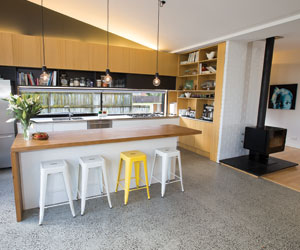
About $100 a month: that’s the peak winter power bill in the Davy household; pretty impressive for a family of four, when similar Auckland households fork out more like $350 in the colder months. So how do they do it?
Peta and Joe Davy, and their boys Andy (11) and Sam (7), live in a beautifully designed eco home in the South Auckland suburb of Mangere Bridge, right on the border of Ambury Farm Park. Their roof is angled so that the high summer sun doesn’t get in, and the house stays cool. But in winter, when the sun is lower, the light reaches right under the eaves where it strikes the bare concrete floor.
“It’s incredible,” says Peta. “I’d heard architects talk about [passive solar] for ages, but I’m just blown away. I can’t believe every house doesn’t have north-facing windows with a concrete floor.”
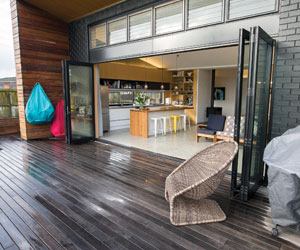
If the day has been sunny the floor is warm all night – and conveniently, the clear days that are sunniest in winter are usually followed by the coldest nights. So in short, the house is warmed when it needs warming.
Another thing that Peta and Joe enjoy about their heating system is the way it feels. Rather than the wafty warm breeze from a heat pump, the heat from the floor, says Peta, is a glow.
“You don’t even notice, but people walk in and say ‘man this house is so warm’, but you can’t feel where it’s coming from.
“Of course the double glazing helps as well.”
Green from the start
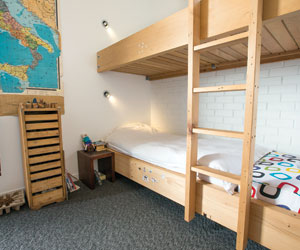
That’s the beauty of building from scratch – you can build these clever ideas in from the start.
Along those lines the Davys also have solar hot water panels on the roof, plus a wetback fire. Joe co-owns The Kauri Warehouse, a business that demolishes old houses and salvages the timber, so the family are never short of free offcuts for the fire. Altogether it means that – unless they have guests and need to switch on the electric hot water for lots of showers in the morning – the Davys spend nothing on heating or hot water year-round – which explains their tiny power bills.
Environmentally the downside of building a new house is the high ‘embedded energy’ of all the new materials; new components all have impacts, and require packaging and transport. However the Davys were able to avoid much of the impact of building from scratch by using recycled materials throughout.
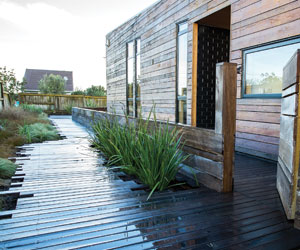
Through his business Joe was able to source old hardwood power poles which now clad the home’s entire exterior. Made from “some kind of Australian hardwood” and weathered for half a century in the New Zealand outdoors, the timber is incredibly tough and weirdly ‘slidey’ says Peta. When it was first cut it couldn’t even be stacked, as the densely-grained beams simply slid off each other.
To start with the couple planned to let the exterior timber weather off and go grey, but it came up such a beautiful colour when oiled they decided to keep going. Now they oil the outside of the house once every three months, but will soon slow down to once every year, then once every couple of years as the boards slowly soak up the oil.
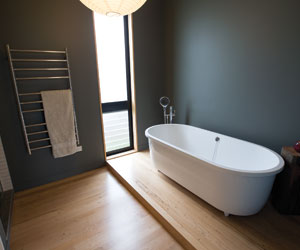
Inside, the timber is also recycled – in this case native tawa, which was recovered from an old state house in Glendowie. And the warm vibe is helped by the fact the house is laid out according to an ancient Vedic tradition – similar to feng shui, but older – that Peta says is her husband’s ‘thing’. All the ceilings are a certain height, and doors are placed facing either east or west according to a formula that is supposed to promote a sense of ease.
That all seems to fly above the heads of the chickens that peck happily around the fringes of the garden. They “poo more than the brochure stated,” laughs Peta. “But what can you do? At least they’re laying.”
